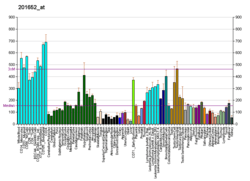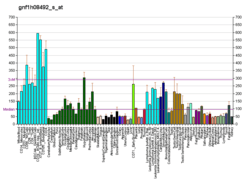COP9 constitutive photomorphogenic homolog subunit 5
COP9 constitutive photomorphogenic homolog subunit 5 (Arabidopsis), also known as COPS5 or Csn5, is a gene conserved from humans to Saccharomyces cerevisiae.[5]
Function
The protein encoded by this gene is one of the eight subunits of COP9 signalosome, a highly conserved protein complex that functions as an important regulator in multiple signaling pathways. The structure and function of COP9 signalosome is similar to that of the 19S regulatory particle of 26S proteasome. COP9 signalosome has been shown to interact with SCF-type E3 ubiquitin ligases and act as a positive regulator of E3 ubiquitin ligases. This protein is reported to be involved in the degradation of cyclin-dependent kinase inhibitor CDKN1B/p27Kip1. It is also known to be a coactivator that increases the specificity of JUN/AP1 transcription factors.[5]
Interactions
COP9 constitutive photomorphogenic homolog subunit 5 has been shown to interact with Macrophage migration inhibitory factor,[6][7] GFER,[8] BCL3,[9] Ubiquitin carboxy-terminal hydrolase L1,[10] S100A7[11] and C-jun.[12]
References
- GRCh38: Ensembl release 89: ENSG00000121022 - Ensembl, May 2017
- GRCm38: Ensembl release 89: ENSMUSG00000025917 - Ensembl, May 2017
- "Human PubMed Reference:". National Center for Biotechnology Information, U.S. National Library of Medicine.
- "Mouse PubMed Reference:". National Center for Biotechnology Information, U.S. National Library of Medicine.
- "Entrez Gene: COPS5 COP9 constitutive photomorphogenic homolog subunit 5 (Arabidopsis)".
- Ghosh S, Leaton LA, Farr L, Barfield A, Moonah S (July 2018). "Interaction between parasite-encoded JAB1/CSN5 and macrophage migration inhibitory factor proteins attenuates its proinflammatory function". Scientific Reports. 8 (1): 10241. doi:10.1038/s41598-018-28625-1. PMC 6035221. PMID 29980718.
- Kleemann R, Hausser A, Geiger G, Mischke R, Burger-Kentischer A, Flieger O, et al. (November 2000). "Intracellular action of the cytokine MIF to modulate AP-1 activity and the cell cycle through Jab1". Nature. 408 (6809): 211–6. doi:10.1038/35041591. PMID 11089976.
- Lu C, Li Y, Zhao Y, Xing G, Tang F, Wang Q, et al. (January 2002). "Intracrine hepatopoietin potentiates AP-1 activity through JAB1 independent of MAPK pathway". FASEB Journal. 16 (1): 90–2. doi:10.1096/fj.01-0506fje. PMID 11709497.
- Dechend R, Hirano F, Lehmann K, Heissmeyer V, Ansieau S, Wulczyn FG, et al. (June 1999). "The Bcl-3 oncoprotein acts as a bridging factor between NF-kappaB/Rel and nuclear co-regulators". Oncogene. 18 (22): 3316–23. doi:10.1038/sj.onc.1202717. PMID 10362352.
- Caballero OL, Resto V, Patturajan M, Meerzaman D, Guo MZ, Engles J, et al. (May 2002). "Interaction and colocalization of PGP9.5 with JAB1 and p27(Kip1)". Oncogene. 21 (19): 3003–10. doi:10.1038/sj.onc.1205390. PMID 12082530.
- Emberley ED, Niu Y, Leygue E, Tomes L, Gietz RD, Murphy LC, Watson PH (April 2003). "Psoriasin interacts with Jab1 and influences breast cancer progression". Cancer Research. 63 (8): 1954–61. PMID 12702588.
- Claret FX, Hibi M, Dhut S, Toda T, Karin M (October 1996). "A new group of conserved coactivators that increase the specificity of AP-1 transcription factors". Nature. 383 (6599): 453–7. doi:10.1038/383453a0. PMID 8837781.
External links
- Human COPS5 genome location and COPS5 gene details page in the UCSC Genome Browser.
Further reading
- Wolf DA, Zhou C, Wee S (December 2003). "The COP9 signalosome: an assembly and maintenance platform for cullin ubiquitin ligases?". Nature Cell Biology. 5 (12): 1029–33. doi:10.1038/ncb1203-1029. PMID 14647295.
- Claret FX, Hibi M, Dhut S, Toda T, Karin M (October 1996). "A new group of conserved coactivators that increase the specificity of AP-1 transcription factors". Nature. 383 (6599): 453–7. doi:10.1038/383453a0. PMID 8837781.
- Asano K, Vornlocher HP, Richter-Cook NJ, Merrick WC, Hinnebusch AG, Hershey JW (October 1997). "Structure of cDNAs encoding human eukaryotic initiation factor 3 subunits. Possible roles in RNA binding and macromolecular assembly". The Journal of Biological Chemistry. 272 (43): 27042–52. doi:10.1074/jbc.272.43.27042. PMID 9341143.
- Seeger M, Kraft R, Ferrell K, Bech-Otschir D, Dumdey R, Schade R, et al. (April 1998). "A novel protein complex involved in signal transduction possessing similarities to 26S proteasome subunits". FASEB Journal. 12 (6): 469–78. doi:10.1096/fasebj.12.6.469. PMID 9535219.
- Wei N, Tsuge T, Serino G, Dohmae N, Takio K, Matsui M, Deng XW (1998). "The COP9 complex is conserved between plants and mammals and is related to the 26S proteasome regulatory complex". Current Biology. 8 (16): 919–22. doi:10.1016/S0960-9822(07)00372-7. PMID 9707402.
- Tomoda K, Kubota Y, Kato J (March 1999). "Degradation of the cyclin-dependent-kinase inhibitor p27Kip1 is instigated by Jab1". Nature. 398 (6723): 160–5. doi:10.1038/18230. PMID 10086358.
- Dechend R, Hirano F, Lehmann K, Heissmeyer V, Ansieau S, Wulczyn FG, et al. (June 1999). "The Bcl-3 oncoprotein acts as a bridging factor between NF-kappaB/Rel and nuclear co-regulators". Oncogene. 18 (22): 3316–23. doi:10.1038/sj.onc.1202717. PMID 10362352.
- Chauchereau A, Georgiakaki M, Perrin-Wolff M, Milgrom E, Loosfelt H (March 2000). "JAB1 interacts with both the progesterone receptor and SRC-1". The Journal of Biological Chemistry. 275 (12): 8540–8. doi:10.1074/jbc.275.12.8540. PMID 10722692.
- Bianchi E, Denti S, Granata A, Bossi G, Geginat J, Villa A, et al. (April 2000). "Integrin LFA-1 interacts with the transcriptional co-activator JAB1 to modulate AP-1 activity". Nature. 404 (6778): 617–21. doi:10.1038/35007098. PMID 10766246.
- Kleemann R, Hausser A, Geiger G, Mischke R, Burger-Kentischer A, Flieger O, et al. (November 2000). "Intracellular action of the cytokine MIF to modulate AP-1 activity and the cell cycle through Jab1". Nature. 408 (6809): 211–6. doi:10.1038/35041591. PMID 11089976.
- Bech-Otschir D, Kraft R, Huang X, Henklein P, Kapelari B, Pollmann C, Dubiel W (April 2001). "COP9 signalosome-specific phosphorylation targets p53 to degradation by the ubiquitin system". The EMBO Journal. 20 (7): 1630–9. doi:10.1093/emboj/20.7.1630. PMC 145508. PMID 11285227.
- Lyapina S, Cope G, Shevchenko A, Serino G, Tsuge T, Zhou C, et al. (May 2001). "Promotion of NEDD-CUL1 conjugate cleavage by COP9 signalosome". Science. 292 (5520): 1382–5. doi:10.1126/science.1059780. PMID 11337588.
- Tomoda K, Kubota Y, Arata Y, Mori S, Maeda M, Tanaka T, et al. (January 2002). "The cytoplasmic shuttling and subsequent degradation of p27Kip1 mediated by Jab1/CSN5 and the COP9 signalosome complex". The Journal of Biological Chemistry. 277 (3): 2302–10. doi:10.1074/jbc.M104431200. PMID 11704659.
- Bae MK, Ahn MY, Jeong JW, Bae MH, Lee YM, Bae SK, et al. (January 2002). "Jab1 interacts directly with HIF-1alpha and regulates its stability". The Journal of Biological Chemistry. 277 (1): 9–12. doi:10.1074/jbc.C100442200. PMID 11707426.
- Lu C, Li Y, Zhao Y, Xing G, Tang F, Wang Q, et al. (January 2002). "Intracrine hepatopoietin potentiates AP-1 activity through JAB1 independent of MAPK pathway". FASEB Journal. 16 (1): 90–2. doi:10.1096/fj.01-0506fje. PMID 11709497.
- Dai YS, Cserjesi P (April 2002). "The basic helix-loop-helix factor, HAND2, functions as a transcriptional activator by binding to E-boxes as a heterodimer". The Journal of Biological Chemistry. 277 (15): 12604–12. doi:10.1074/jbc.M200283200. PMID 11812799.
- Wan M, Cao X, Wu Y, Bai S, Wu L, Shi X, et al. (February 2002). "Jab1 antagonizes TGF-beta signaling by inducing Smad4 degradation". EMBO Reports. 3 (2): 171–6. doi:10.1093/embo-reports/kvf024. PMC 1083965. PMID 11818334.
- Gemmill RM, Bemis LT, Lee JP, Sozen MA, Baron A, Zeng C, et al. (May 2002). "The TRC8 hereditary kidney cancer gene suppresses growth and functions with VHL in a common pathway". Oncogene. 21 (22): 3507–16. doi:10.1038/sj.onc.1205437. PMID 12032852.
- Caballero OL, Resto V, Patturajan M, Meerzaman D, Guo MZ, Engles J, et al. (May 2002). "Interaction and colocalization of PGP9.5 with JAB1 and p27(Kip1)". Oncogene. 21 (19): 3003–10. doi:10.1038/sj.onc.1205390. PMID 12082530.
- Chopra S, Fernandez De Mattos S, Lam EW, Mann DJ (September 2002). "Jab1 co-activation of c-Jun is abrogated by the serine 10-phosphorylated form of p27Kip1". The Journal of Biological Chemistry. 277 (36): 32413–6. doi:10.1074/jbc.C200311200. PMID 12119282.





